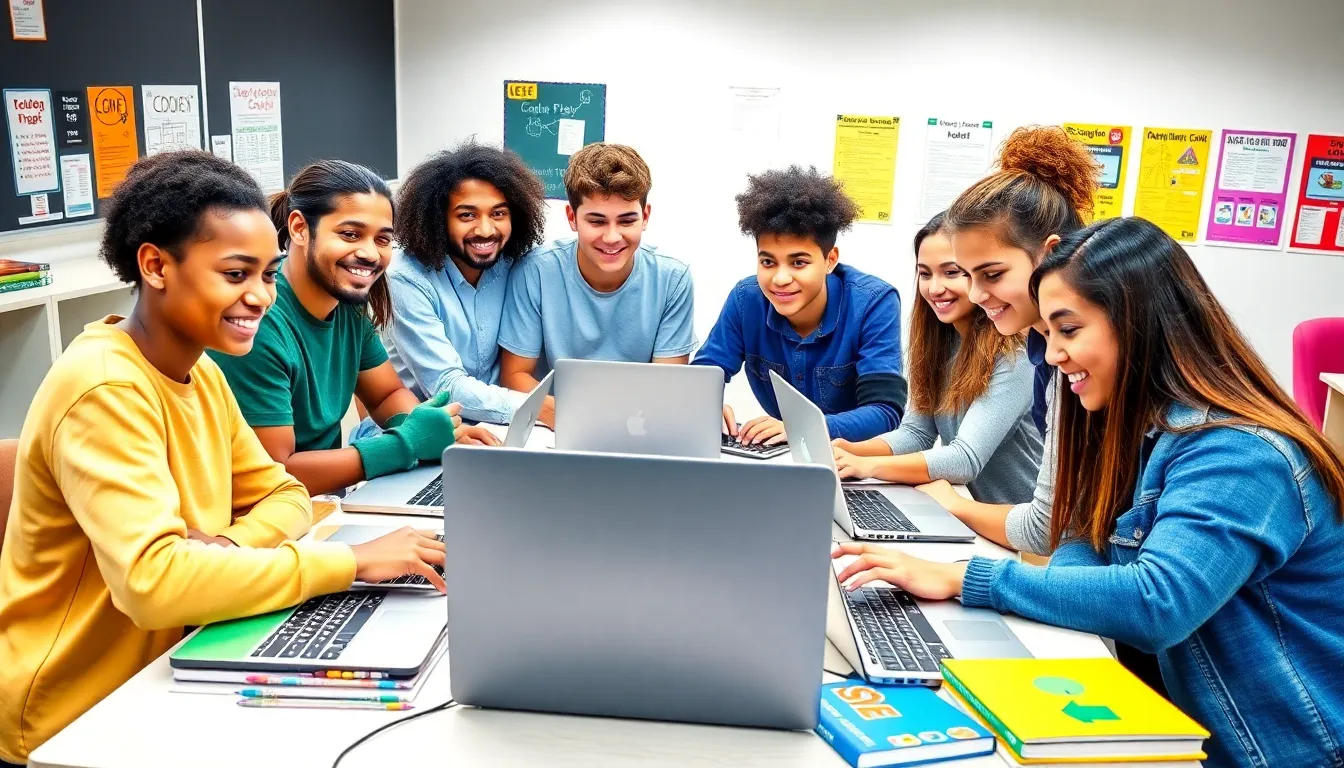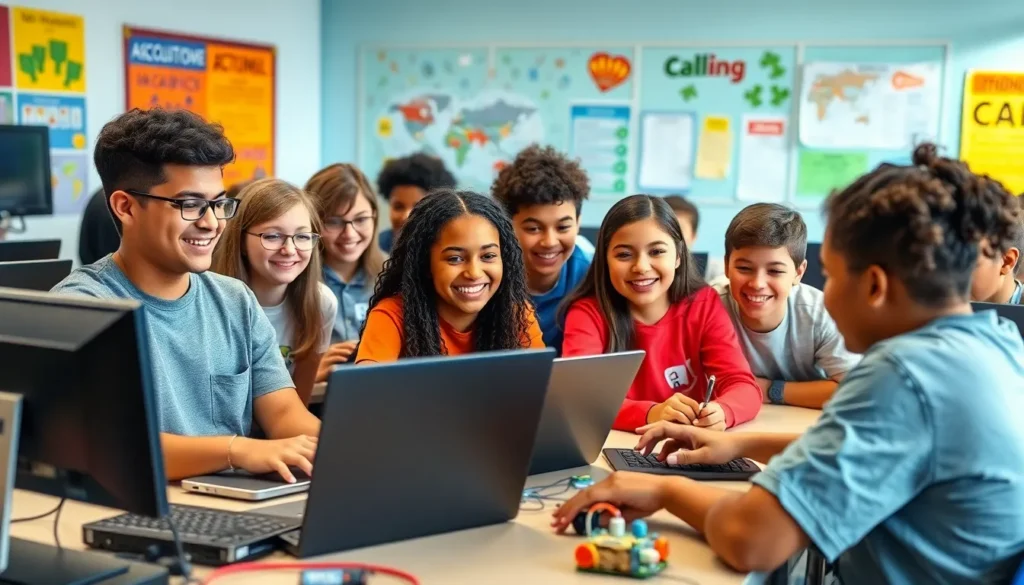Table of Contents
ToggleIn a world where TikTok dances and memes reign supreme, coding might seem like the last thing on a teen’s mind. But what if they could turn their screen time into something more productive—like creating their own video game or app? Coding isn’t just for tech wizards in hoodies; it’s a superpower that can unlock endless possibilities and future career paths.
Overview of Coding Tutorials for Teens
Coding tutorials for teens serve as valuable resources for learning programming skills. Many platforms offer interactive courses designed specifically for a younger audience. Popular languages like Python and JavaScript feature prominently in these tutorials, catering to beginners who want to engage with coding.
Numerous websites provide free and paid tutorials, making accessibility a priority. Codecademy, Khan Academy, and Scratch are notable examples. These platforms often include multimedia elements, such as videos and interactive exercises. Collaboration through online forums and coding communities enhances the learning experience, allowing teens to ask questions and share knowledge.
Projects encouraged in these tutorials foster creativity. Building games or apps provides practical applications of coding concepts. Feedback from peers and instructors on these projects cultivates a supportive learning environment. Competition through coding challenges also motivates teens to improve their skills.
Schools increasingly incorporate coding into the curriculum, recognizing its significance. Many educational institutions offer after-school clubs that focus on programming, giving teens opportunities to learn in a social setting. Workshops and summer camps provide intensive coding experiences that further enhance learners’ skills.
Continuous updates to tutorials ensure relevance in the fast-evolving tech landscape. Staying current with programming trends and tools promotes engaging and effective learning. Ultimately, coding tutorials empower teens to transform their digital skills into real-world applications.
Popular Coding Languages for Teens

Learning coding languages opens up new avenues for teens. Three popular options include Python, JavaScript, and Scratch, each offering unique advantages.
Python
Python stands out due to its simplicity and readability. Many beginners find it easy to grasp, making it ideal for those just starting. Young coders can create web applications, games, and automation scripts with Python. Libraries such as Pygame and Django provide resources for game development and web building, respectively. Interactive tutorials on platforms like Codecademy and Khan Academy help reinforce concepts. Engaging with Python fosters problem-solving skills and logical thinking.
JavaScript
JavaScript plays a crucial role in web development. It enables teens to create dynamic and interactive websites. Learning JavaScript enhances understanding of how websites function, as it runs in the browser. Teens can work with frameworks like React and Vue.js for building user interfaces. Numerous online courses offer hands-on projects that lead to immediate results. Gaining proficiency in JavaScript often opens career paths in tech-focused fields.
Scratch
Scratch introduces programming concepts through visually appealing blocks. Designed for younger audiences, it allows teens to create animations and games intuitively. Building projects with Scratch encourages creativity while teaching fundamental programming logic. Users can share their work within the Scratch community, fostering collaboration and feedback. This platform often serves as a stepping stone to more complex languages, laying a strong foundation. Engaging with Scratch builds confidence in coding abilities.
Types of Coding Tutorials
Several options exist for teens eager to learn coding. Each type of tutorial offers unique advantages that cater to different learning styles and preferences.
Online Platforms
Online platforms provide interactive and structured courses for teens. Websites like Codecademy, Khan Academy, and freeCodeCamp offer step-by-step tutorials in languages such as Python and JavaScript. These platforms usually incorporate quizzes and projects to reinforce learning. Gamified elements keep learners engaged through rewards and badges. Teens benefit from a flexible learning schedule, allowing them to progress at their own pace and revisit challenging concepts. Additionally, many platforms feature community forums, promoting collaboration and peer assistance.
Coding Bootcamps
Coding bootcamps offer immersive and intensive learning experiences. Programs typically last from a few weeks to several months, giving teens the chance to focus deeply on coding. Campuses or online formats often host these bootcamps, providing expert instruction in various programming languages and concepts. Additionally, many bootcamps emphasize real-world applications and project-based learning, helping participants build portfolios. Interaction with instructors and peers fosters a collaborative atmosphere, enhancing the overall learning experience for young coders.
YouTube Channels
YouTube channels serve as valuable resources for visual learners. Numerous channels, such as The Net Ninja, Traversy Media, and CS Dojo, publish coding tutorials ranging from beginner to advanced levels. Videos often break down complex concepts into manageable segments, making it easier to grasp programming fundamentals. Engaging content, like live coding sessions and coding challenges, captures the interest of teens. Viewers can comment and ask questions, fostering community interaction. Access to a variety of tutorials enhances flexibility and accommodates different learning paces.
Benefits of Learning to Code
Learning to code provides numerous advantages, particularly for teens. It enhances cognitive abilities and opens doors to future career paths.
Enhancing Problem-Solving Skills
Coding strengthens problem-solving skills through logical reasoning and structured thinking. Each project presents unique challenges that require analysis and creative solutions. Engaging with coding encourages teens to break down complex problems into manageable parts. This practice fosters resilience as they troubleshoot bugs and refine their code. Developing effective coding strategies lays a strong foundation for addressing real-world issues.
Career Opportunities
Career opportunities in technology continue to grow at a rapid pace. Knowledge of coding languages like Python and JavaScript equips teens with a valuable skill set sought by employers. Many industries leverage tech skills, from gaming to healthcare, demonstrating a wide range of possibilities. Engaging with coding tutorials enhances marketability and indicates a proactive approach to learning. Participating in coding projects often leads to internships or freelance opportunities, setting teens on a path to successful careers.
Embracing coding can significantly benefit teens by transforming their digital engagement into valuable skills. With a wealth of tutorials available, young learners can explore programming languages that spark their interest and creativity. The supportive environments fostered by online platforms and coding communities encourage collaboration and innovation.
As schools increasingly integrate coding into their curricula, teens have more opportunities than ever to develop these essential skills. By diving into coding, they not only enhance their problem-solving abilities but also prepare for a future filled with exciting career possibilities. The journey into coding is not just about learning a language; it’s about empowering the next generation to thrive in a technology-driven world.







